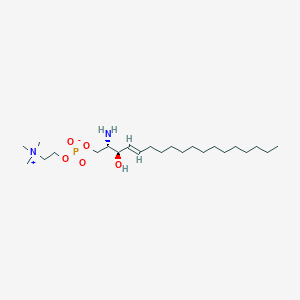| MeSH term | MeSH ID | Detail |
|---|---|---|
| Lupus Erythematosus, Systemic | D008180 | 43 associated lipids |
| Insulinoma | D007340 | 28 associated lipids |
| Pancreatic Neoplasms | D010190 | 77 associated lipids |
| Seizures | D012640 | 87 associated lipids |
| Niemann-Pick Diseases | D009542 | 25 associated lipids |
| Endotoxemia | D019446 | 27 associated lipids |
| Niemann-Pick Disease, Type A | D052536 | 1 associated lipids |
| Niemann-Pick Disease, Type B | D052537 | 1 associated lipids |
sphingosylphosphorylcholine
sphingosylphosphorylcholine is a lipid of Sphingolipids (SP) class. Sphingosylphosphorylcholine is associated with abnormalities such as Cerebral Vasospasm, Subarachnoid Hemorrhage, Atherosclerosis, Hypertensive disease and Niemann-Pick Diseases. The involved functions are known as MAP kinase kinase activity, JUN kinase activity, Phosphorylation, biphenyl synthase activity and Cell Death. Sphingosylphosphorylcholine often locates in Adipose tissue, Protoplasm, Body tissue, Membrane and Extracellular. The associated genes with sphingosylphosphorylcholine are UCN3 gene, MAPK9 gene, JUN gene, NAA50 gene and P4HTM gene. The related lipids are Lysophospholipids, lysophosphatidic acid, Lysophosphatidylcholines, Sphingolipids and Saponin. The related experimental models are Mouse Model.
Cross Reference
Introduction
To understand associated biological information of sphingosylphosphorylcholine, we collected biological information of abnormalities, associated pathways, cellular/molecular locations, biological functions, related genes/proteins, lipids and common seen animal/experimental models with organized paragraphs from literatures.
What diseases are associated with sphingosylphosphorylcholine?
sphingosylphosphorylcholine is suspected in Atherosclerosis, Niemann-Pick Diseases, Hypercholesterolemia, Dermatitis, Atopic, Chronic eczema, Cerebral Vasospasm and other diseases in descending order of the highest number of associated sentences.
Related references are mostly published in these journals:
| Disease | Cross reference | Weighted score | Related literature |
|---|
Possible diseases from mapped MeSH terms on references
We collected disease MeSH terms mapped to the references associated with sphingosylphosphorylcholine
PubChem Associated disorders and diseases
What pathways are associated with sphingosylphosphorylcholine
Lipid pathways are not clear in current pathway databases. We organized associated pathways with sphingosylphosphorylcholine through full-text articles, including metabolic pathways or pathways of biological mechanisms.
Related references are published most in these journals:
| Pathway name | Related literatures |
|---|
PubChem Biomolecular Interactions and Pathways
Link to PubChem Biomolecular Interactions and PathwaysWhat cellular locations are associated with sphingosylphosphorylcholine?
Visualization in cellular structure
Associated locations are in red color. Not associated locations are in black.
Related references are published most in these journals:
| Location | Cross reference | Weighted score | Related literatures |
|---|
What functions are associated with sphingosylphosphorylcholine?
Related references are published most in these journals:
| Function | Cross reference | Weighted score | Related literatures |
|---|
What lipids are associated with sphingosylphosphorylcholine?
Related references are published most in these journals:
| Lipid concept | Cross reference | Weighted score | Related literatures |
|---|
What genes are associated with sphingosylphosphorylcholine?
Related references are published most in these journals:
| Gene | Cross reference | Weighted score | Related literatures |
|---|
What common seen animal models are associated with sphingosylphosphorylcholine?
Mouse Model
Mouse Model are used in the study 'Sphingosylphosphorylcholine induces a hypertrophic growth response through the mitogen-activated protein kinase signaling cascade in rat neonatal cardiac myocytes.' (Sekiguchi K et al., 1999).
Related references are published most in these journals:
| Model | Cross reference | Weighted score | Related literatures |
|---|
NCBI Entrez Crosslinks
All references with sphingosylphosphorylcholine
Download all related citations| Authors | Title | Published | Journal | PubMed Link |
|---|---|---|---|---|
| Okamoto H et al. | EDG3 is a functional receptor specific for sphingosine 1-phosphate and sphingosylphosphorylcholine with signaling characteristics distinct from EDG1 and AGR16. | 1999 | Biochem. Biophys. Res. Commun. | pmid:10381367 |
| Wiktorek-Wójcik M et al. | Serine base exchange enzyme activity is modulated by sphingosine and other amphiphilic compounds: possible role of positive charge in increasing the synthesis of phosphatidylserine. | 1997 | Biochem. Biophys. Res. Commun. | pmid:9405236 |
| Boguslawski G et al. | Sphingosylphosphorylcholine induces endothelial cell migration and morphogenesis. | 2000 | Biochem. Biophys. Res. Commun. | pmid:10833459 |
| Desai NN and Spiegel S | Sphingosylphosphorylcholine is a remarkably potent mitogen for a variety of cell lines. | 1991 | Biochem. Biophys. Res. Commun. | pmid:1958205 |
| Liu R et al. | Effects of sphingosine derivatives on MC3T3-E1 pre-osteoblasts: psychosine elicits release of calcium from intracellualr stores. | 1995 | Biochem. Biophys. Res. Commun. | pmid:7677781 |
| Yue H et al. | Inhibition of autophagy promoted sphingosylphosphorylcholine induced cell death in non-small cell lung cancer cells. | 2014 | Biochem. Biophys. Res. Commun. | pmid:25285628 |
| Strasberg PM and Callahan JW | Lysosphingolipids and mitochondrial function. II. Deleterious effects of sphingosylphosphorylcholine. | 1988 | Biochem. Cell Biol. | pmid:2977568 |
| Orlati S et al. | Intracellular calcium mobilization and phospholipid degradation in sphingosylphosphorylcholine-stimulated human airway epithelial cells. | 1998 | Biochem. J. | pmid:9729473 |
| Kovacs E and Liliom K | Sphingosylphosphorylcholine as a novel calmodulin inhibitor. | 2008 | Biochem. J. | pmid:17979830 |
| Törnquist K and Ekokoski E | Effect of sphingosine derivatives on calcium fluxes in thyroid FRTL-5 cells. | 1994 | Biochem. J. | pmid:8166643 |
